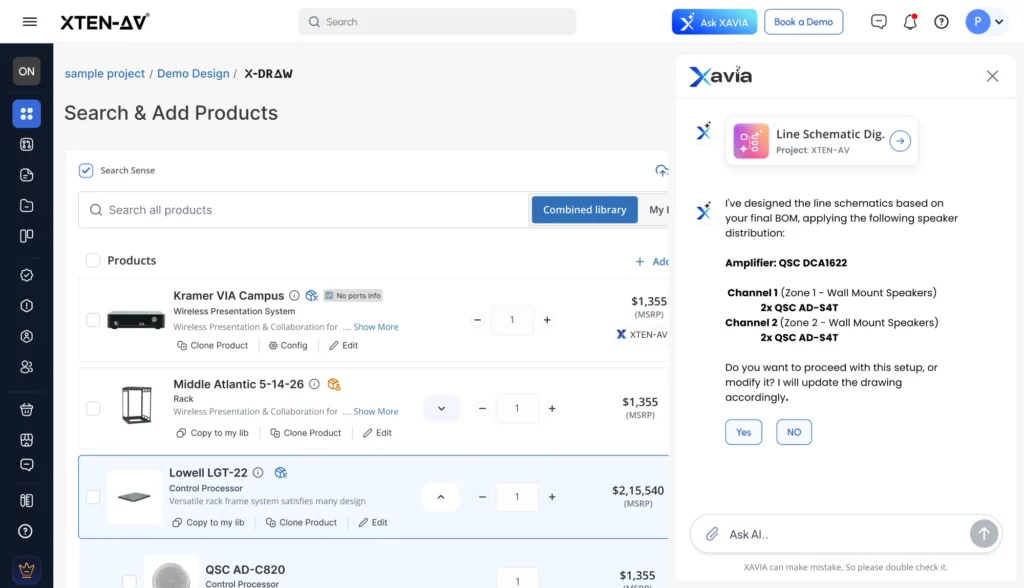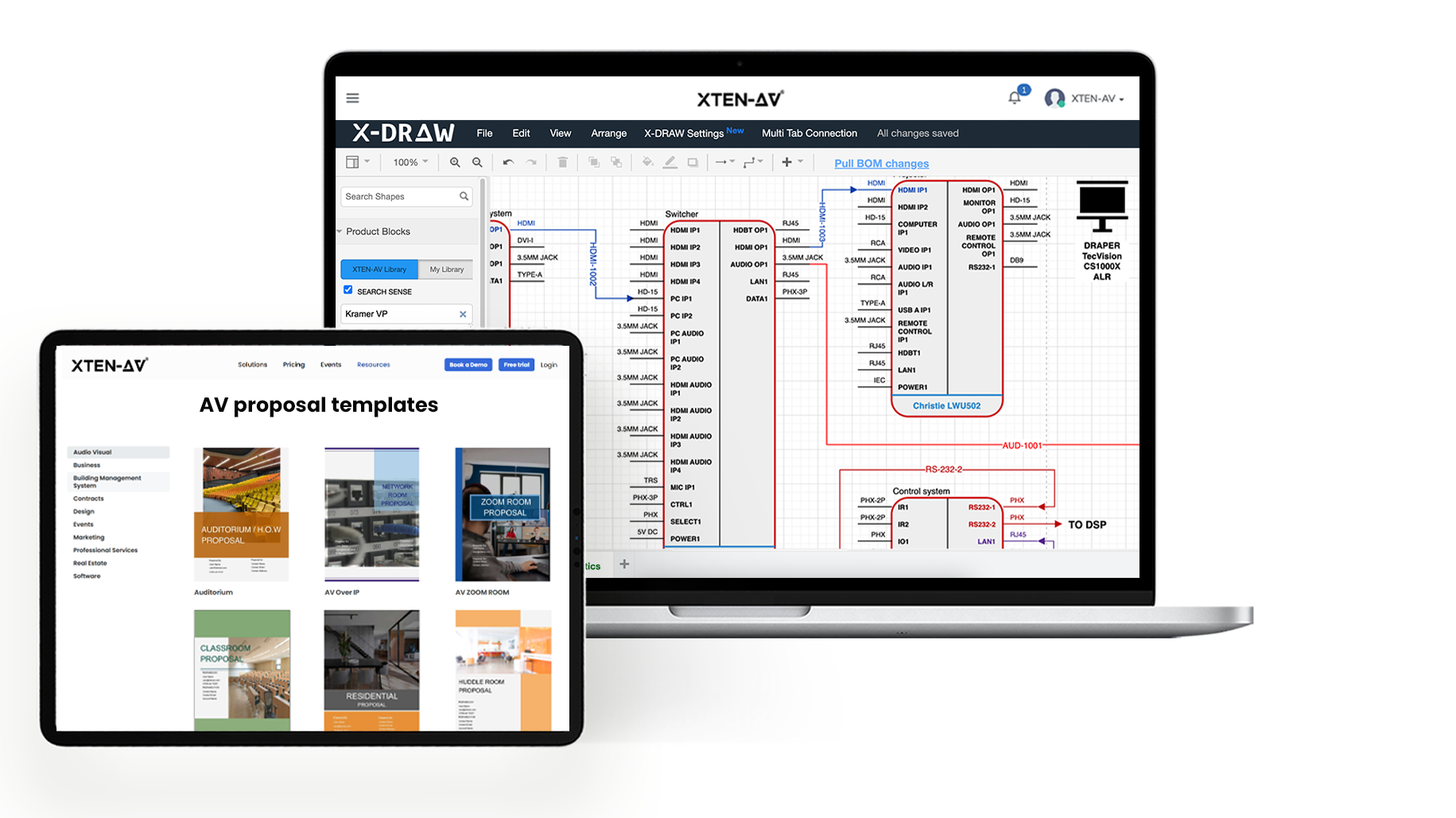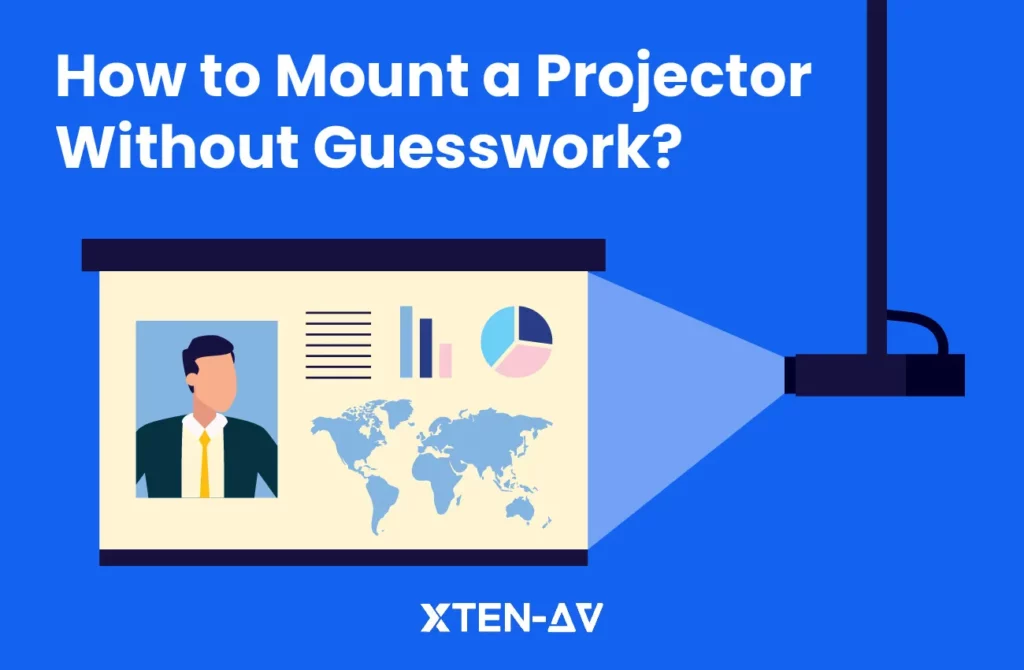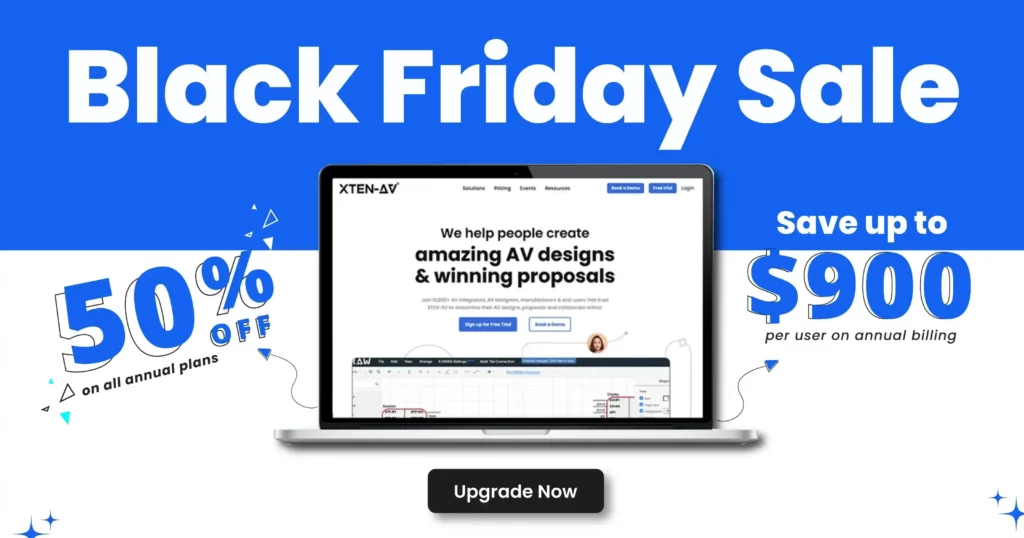Navigating modern complex audiovisual system designs forces AV professionals to evaluate better diagramming software under tight deadlines. Selecting specialized AV Diagramming software with extensive, industry‑leading symbol libraries often proves surprisingly challenging.
Seamless integration with multiple platforms and real‑time BOM syncing remain essential features for effective workflow management in collaboration. Choosing the ideal tool can significantly impact project timelines, collaboration efficiency, and on‑site installation accuracy.
Therefore, we present an extensive comparison guide on XTEN‑AV vs. Draw.io. This comprehensive guide compares the features, pricing, and workflow in depth to offer enhanced clarity. AV designers can find platform strengths, limitations, and unique AV automation capabilities deeply in this analysis.
They will also discover how XTEN‑AV enhances AV schematic automation while Draw.io offers versatile diagramming capabilities. This guide also provides clear insights into AV collaboration tools, symbol library management, and cost transparency across workflows.
As a result, you can make a confident decision by evaluating AI assistant support, API extensibility, and live cost integration. Continue reading to learn all about the comparison of XTEN‑AV vs. Draw.io and figure out the best diagrammatic software for audio-visual system design.
Key Takeaways:
- XTEN‑AV offers specialized AV templates that enforce correct aspect ratio and seating layout calculations. It also provides schematic automation and reduces setup time by automatically handling field-of-view constraints. On the other hand, Draw.io’s generic flow chart maker demands manual adjustments and lacks AV context entirely.
- XTEN‑AV maintains comprehensive symbol libraries, comprising daily automatic updates as per AVIXA standards. Its integration supports custom icon uploads, preserving brand consistency across enterprise‑grade audio visual diagrams seamlessly. On the contrary, Draw.io requires manual symbol imports, often resulting in inconsistent visuals and technical data inaccuracies.
- XTEN‑AV supports secure enterprise real‑time collaboration with granular permissions and detailed audit trails. Its version snapshots and comment threads accelerate issue resolution and improve audit compliance processes. However, Draw.io enables simultaneous editing but lacks component‑level change tracking and role‑based permission controls.
- XTEN‑AV offers native integrations with CAD, CRM, and procurement systems via REST API seamlessly. Real‑time cost data synchronization updates BOM pricing accurately via AV Design Automation. Draw.io supports cloud storage connectors only, lacking an AV product catalog and cost data integration processes.
- XTEN‑AV’s subscription plans offer tiered features, a free trial, and enterprise discount options effectively. The integration of real-time data around costs with sync pricing from vendors provides accurate, complete budget visibility in an instant. Draw.io is free but has no support, SLAs, or cost management. These aspects are crucial for the AV industry.
The all-in-one solution for your AV needs
Transform your audio-visual experience with XTEN-AV.
No Credit Card required
XTEN-AV and Draw io Comparison
Understanding AV system design requires transparency around platform capabilities, limitations, and integration opportunities. This comparison puts two leading diagramming tools side by side.
Each solution enables AV professionals to handle AV workflows, from schematic generation to bill‑of‑materials management. Insight into core strengths and weaknesses empowers AV professionals to select the ideal diagramming platform.
With that said, let’s dive into detailed overviews of XTEN‑AV and Draw.io.
XTEN-AV
XTEN‑AV positions itself as a professional AV diagramming platform focused on audiovisual system accuracy. It targets integrators, consultants, and engineers who need reliable AV‑centric workflows.
Unlike general drawing tools, XTEN‑AV enforces standardized design practices and precise documentation across global teams. Its cloud‑native design ensures secure data storage, seamless updates, and real‑time collaboration.
The platform remains available for users with a 99.9% service level agreement (SLA) for uninterrupted enterprise access. Compliance includes role‑based access control, audit logging, and end-to-end encryption of user data. This demonstrates XTEN-AV’s dedication to technical fidelity and program continuity during complex AV installations.
Core Capabilities
At the center of the XTEN-AV ecosystem is its strong AV design automation engine that streamlines schematic production. This engine auto-generates signal flow diagrams, rack elevations, and a few floor plans based on particular logic and hardware data.
XTEN-AV features real‑time BOM syncing, ensuring that any schematic change automatically updates the materials list, eliminating procurement discrepancies. Designers benefit from built‑in consistency between visual layouts and cost data.
The integrated XAVIA AI assistant provides contextual device recommendations, validates signal path integrity, and highlights configuration gaps. XAVIA’s machine‑learning insights reduce design errors and help maintain compliance with AVIXA standards.
Revision history enables the tracking of project modifications, providing teams with improved multi‑user collaboration without the risk of potential conflicts with versioning. Custom user templates offer teams the ability to recreate system configurations of similar types of projects quickly.
Integrations:
XTEN‑AV integrates with core platforms to provide an end-to-end AV project workflow. With the integration of AutoCAD, AV designers can work with architects to collaboratively design programs and collaborate on schematics and building plans to lead to improved spatial coordination.
On the other hand, Salesforce connectivity embeds proposal data directly within CRM records, speeding sales cycles. Google Drive sync enables real‑time file sharing and version control across distributed teams.
Additional integrations include catalogs for Biamp devices intended for speaker placement workflows, along with Zapier bridges for automated notifications and reporting in external applications.
A complete REST API also allows custom data transfers and sophisticated analytics. These integrations enable XTEN‑AV to fit smoothly into an existing enterprise ecosystem to minimize friction and improve productivity.
Pricing Model:
XTEN‑AV has subscription levels for individual designers, smaller firms, and large AV enterprises. The subscription levels vary in terms of user seats, number of automations, and premium integrations.
Core features remain accessible in all plans, with advanced AV design automation reserved for higher tiers. Annual billing customers receive discounted rates and priority support channels for expedited issue resolution.
A free trial grants temporary access to full diagramming, BOM syncing, and proposal tools for comprehensive evaluation. Onboarding services include live training sessions and documentation to accelerate user adoption.
This flexible pricing model aligns with diverse AV project budgets and scales as design teams grow. When comparing XTEN‑AV vs Draw.io, these subscription options highlight XTEN‑AV’s AV‑focused value proposition.
Draw io
Platform Scope
Draw.io is a browser‑based flowchart and diagramming tool built for generic business and technical audiovisual diagrams. It provides a simple canvas for process flows, organizational charts, network maps, and mind maps.
Draw.io comprises a zero‑install, drag‑and‑drop interface that enables quick diagram creation without software downloads. As an open‑source solution, Draw.io encourages community‑driven improvements, template sharing, and developer customization.
Teams can embed Draw.io in internal portals or integrate it into documentation systems. When reviewing Tools similar to Draw.io, users often choose it for its accessibility and low learning curve. Nonetheless, while it is a general-purpose scope, it does not have AV-specific design logic, which is necessary for accuracy in any audiovisual system.
Key Strengths
The most substantial benefit of Draw.io is its ease of use, with a vast library of templates that accommodate many different types of diagrams. The free usage tier is its most significant benefit because there is full functionality for diagramming without a licensing fee, and the ability to have unlimited documents and collaborators.
Draw.io’s export diagrams in PNG, SVG, PDF, and other formats for diverse reporting needs. Real‑time collaboration features include simultaneous editing, comment threads, and revision history for auditability.
Cloud storage integrations with Google Drive, OneDrive, and Dropbox allow seamless manipulation of files. Developers benefit from the open-source option of the Draw.io engine.
Hence, AV designers can embed their proprietary systems or adapt elements through the plugins available. Together, these benefits make Draw.io appealing for basic visualization tasks applied externally to more sophisticated AV contexts.
Limitations for AV Pros
Draw io’s versatility is due to the lack of symbol libraries designed for audiovisual equipment, connectors, and standards. It does not support real‑time BOM updates, meaning AV professionals must manually maintain material lists.
Without automation, users risk specification errors when managing complex AV signal chains or rack elevations. Draw.io also offers no built‑in proposal generation workflows or device compatibility validation.
Draw.io features limited integration options to generic cloud storage and basic API endpoints, not AV product catalogs or CRM platforms. These gaps increase manual effort and project risk for AV professionals handling large‑scale system designs. Draw io’s model also omits enterprise‑grade support and advanced security controls necessary for regulated environments.
Feature Comparison: Draw io vs XTEN-AV
Evaluating AV platforms requires comparing diagramming capabilities, assets, collaboration, integrations, and pricing structures. XTEN‑AV and Draw.io differ significantly in handling aspect ratio, seating layout, and field of view.
Only XTEN‑AV delivers real‑time cost data synchronization, AV automation, and professional diagram accuracy. With that said, here’s a deep dive analysis for a comprehensive feature comparison.
Diagramming & Templates
XTEN‑AV offers specialized AV templates that enforce correct aspect ratio calculations seamlessly. Its template library includes seating layout presets optimized for audience sightlines and coverage.
Built‑in controls adjust the field of view representations based on the projector throw distances accurately. Designers can customize scale settings and grid alignment to match architectural drawings precisely.
Template categories cover signal flow diagrams, rack elevations, and configurable floor plans effortlessly. Each template automatically applies AVIXA best practices for projector positioning and speaker coverage angles.
By contrast, Draw.io provides generic flowcharts and process templates lacking AV‑specific context. Users must manually resize shapes and adjust proportions to approximate the correct aspect ratio and placement.
Seating layout elements requires importing or designing custom shapes without predefined AV logic. Field-of-view visualizations do not exist natively, forcing designers to create manual overlays.
While Draw.io excels in broad diagramming scenarios, its canvas demands extensive manual edits for professional AV accuracy. XTEN‑AV significantly reduces setup time by delivering ready‑to‑use AV templates that respect critical design constraints.
Symbol Libraries & AV‑specific assets
XTEN‑AV maintains a comprehensive set of symbol libraries updated regularly with new device icons and connection symbols. These libraries include industry‑standard audio DSPs, video switchers, and amplifier block audio visual diagrams.
Users can drag and drop certified AVIXA‑compliant symbols into schematics without manual resizing or relabeling. Connector and cable icons automatically adapt to selected hardware specifications to preserve technical accuracy. Custom symbol creation workflows allow teams to upload proprietary equipment shapes and share them across projects.
Draw.io, however, relies on a public shape repository with no AV focus. Users must import generic shapes or recreate AV symbols manually, leading to inconsistent visual standards.
There is no real‑time synchronization of symbol updates from manufacturers, forcing manual library maintenance. XTEN‑AV’s XAVIA AI assistant even suggests symbols based on hardware lists, helping speed up the design process.
When using Draw.io, the selection of symbols is entirely manual and open to mistakes for AV professionals. The difference in the number of available assets illustrates XTEN‑AV’s ability to provide AV documentation that is accurate and standardized from the start.
Collaboration & Revision Control
XTEN‑AV implements robust collaboration features designed for AV project teams working across locations. Its cloud‑native architecture supports simultaneous multi‑user editing with conflict resolution safeguards.
Granular permission controls allow for role-based access so that only the right person is able to make changes to the essential components of a diagram. Real-time change tracking will log all changes down to the logs when any schematic change is made, so audit trails and handovers become easy.
You can create comment threads on specific diagram elements, allowing you to get relevant feedback. Version snapshots allow users to revert to any historical state instantly, preserving design integrity.
Draw.io offers real‑time collaborative editing and basic revision history for diagram versions. However, it lacks advanced permission settings and component‑level commenting features. Users cannot assign role‑based editing rights or lock individual diagram layers.

Integrations & API
XTEN‑AV provides native integrations with essential AV and enterprise platforms to enhance end‑to‑end workflows. Its AutoCAD connection allows importing DWG files for architectural coordination and reference layer alignment. Salesforce integration automatically syncs proposal data from schematics to CRM opportunities, streamlining sales handoffs and processes.
Real-time cost data syncing through REST API keeps BOM pricing up to date based on approved vendor catalogs. Zapier connectors provide automation of notifications, reports, and document exports without custom code.
The open REST API supports lots of custom plugins and development for custom analytics or reporting based on your requirements. Conversely, Draw.io’s integration ecosystem features cloud storage providers like Google Drive and OneDrive only.
It lacks direct connections to CAD systems, CRM platforms, or cost databases. There is no real‑time cost data API or automated BOM export functionality.
Custom integration requires significant development effort using generic APIs. XTEN-AV is going to be a clear choice for AV professionals looking for a simple data flow between design, procurement, and sales, with the other clear benefits of interconnectivity and extensibility.
Pricing & Packaging
The pricing model for XTEN-AV comprises tiered subscription plans designed to cater to varying team sizes and project complexity. The baseline entry-level plans enable core diagramming, basic AV design automation, and limited access to the symbol library.
Mid‑tier subscriptions unlock advanced real‑time BOM syncing, XAVIA AI assistant recommendations, and priority support features. Enterprise packages offer custom branding, extended API usage limits, and dedicated account management.
All paid plans come with a free trial, allowing you to explore comprehensive features before committing. Annual billing options provide cost savings and predictable budgeting for multi‑year AV engagements.
Draw.io pricing is entirely free for all users, with no subscription tiers or enterprise support SLAs. While cost‑effective for generic cad diagrams, its lack of premium support and advanced features impacts enterprise readiness.
Draw.io also does not have structured enterprise discounts available for large deployments. XTEN-AV’s packaged pricing reflects the AV industry’s ability to demonstrate depth of features with predictable investment to ensure that all professional design teams have the right tools to deliver projects regardless of scale.
Here’s a side-by-side comparison table for a better understanding:
Feature | XTEN‑AV | Draw.io |
Diagramming & Templates | Predefined AV templates support correct aspect ratio, seating layout, and field of view. | General templates lack AV context, requiring manual adjustments for aspect ratio and view. |
Symbol Libraries & AV‑specific assets | Comprehensive symbol libraries updated automatically and regularly with AVIXA‑standard device icons and connectors. | No built‑in AV asset library; users import generic shapes or custom symbols manually. |
Collaboration & Revision Control | Real‑time multi‑user editing features include granular change tracking and advanced permission controls. | Simultaneous editing with basic revision history but lacks granular permission settings and role‑based control. |
Integrations & API | Native integrations with CAD, CRM, and real‑time cost data sync via REST API. | Limited to cloud storage connectors; no direct AV integrations or cost data API. |
Pricing & Packaging | Tiered subscription plans with free trial and enterprise discounts for bulk licensing. | Completely free tool; no subscription tiers but lacks enterprise support or discounts. |
XTEN-AV and Draw io: When should you choose what?
Choosing between diagramming tools depends on your project type and requirements. AV professionals can examine use cases like general visuals versus AV‑specific planning, budgeting constraints, and workflow duration.
The examination helps AV professionals select the most suitable platform for each stage of their process. This analysis ensures precise tool selection for varied AV project requirements.
Small‑Scale/General Diagrams vs AV‑Specific Projects
For small‑scale diagrams, Draw.io’s intuitive canvas supports quick organizational charts, and basic process flows efficiently. It allows for seating layout sketches without complex configuration or AV template requirements.
However, XTEN‑AV delivers specialized AV design templates, ensuring correct aspect ratio and projection accuracy immediately. Its floor plan templates automatically calculate the field of view (for diagrams) and speaker coverage patterns.
Configurable rack layouts and cabling diagrams reduce manual edits for complex AV setups significantly. Draw.io requires manual resizing of shapes to match the correct aspect ratio for AV diagrams.
It lacks built‑in field-of-view calculations and seating layout optimization presets by default. XTEN‑AV’s ready‑made templates save time and vastly improve AV deployment precision for integrators.
Budget‑Conscious/Free‑Tool Use vs Enterprise Integration
Budget‑conscious small teams often start with free tools like Draw.io for quick starts and efficiency. Draw.io’s zero‑cost model suits occasional diagramming without subscription constraints or licensing requirements.
Conversely, XTEN‑AV offers scalable subscription tiers designed for enterprise integration needs with security and support. Its plans include real‑time cost data synchronization and vendor pricing updates automatically via.
XTEN‑AV integrates with Multiple Platforms for CAD, CRM, and procurement systems seamlessly today. These features ensure predictable budgeting and robust audit trails for large organizations that are globally distributed.
Draw.io lacks formal support, enterprise SLAs, or advanced audit and security controls features altogether. For budget versus capability decisions, XTEN‑AV offers superior value through professional features everywhere reliably.
One‑Off Diagrams vs. Ongoing AV BOM/Proposal Workflows
One‑off presentations often work well with Draw.io’s easy export options and simple interface. Designers can quickly share basic diagrams without integrating project costing or equipment data manually.
XTEN‑AV excels in ongoing AV workflows by linking diagrams to real‑time cost data seamlessly. Its automatic BOM updates trigger part list revisions across cabinets and racks instantly and accurately.
Proposal generation tools embed AV diagrams directly into client deliverables for workflow integrity. Draw.io requires exporting diagrams and manually compiling spreadsheets for bill‑of‑materials tasks, which are frequently time-consuming, too.
Without automation, manual updates risk mismatched part quantities and outdated cost data errors. For repeatable AV deployments, XTEN‑AV’s integrated workflows deliver faster, error‑free outcomes consistently globally every day.
XTEN-AV: An Alternative to draw.io
XTEN‑AV is the superior AV‑tailored alternative that emphasizes its technical precision advantages. General diagramming tools fall short for audiovisual projects demanding stringent design accuracy and workflow automation.
XTEN‑AV bridges these gaps, delivering end‑to‑end AV documentation, symbol management, and real‑time cost integration that generic platforms cannot match.
Why General Tools Fall Short
General diagramming platforms like Draw.io lack AV‑specific automation for accurate aspect ratio management. Users must manually adjust projector templates to approximate the correct field of view visuals each time.
Seating layout planning requires extensive edits without predefined AV coverage presets or speaker placement logic. No built-in symbol libraries force manual imports and inconsistencies in technical documentation.
Draw.io does not calculate the field of view (fov) for diagrams or validate rack elevations against AV standards automatically. Exports lack embedded real‑time cost data, pushing teams to reconcile spreadsheets separately.
Signal path validation remains impossible, increasing the risk of specification errors during installations. Field engineers often encounter mismatched diagrams and on‑site realities, causing rework. For professional AV deployments, reliance on generic tools slows workflows significantly.
XAVIA AI Assistant
XTEN‑AV features the XAVIA AI assistant to recommend AV devices based on system requirements automatically. It analyzes connection logic, validates signal flows, and predicts gaps before installation begins. Design teams receive ranked recommendations for compatible hardware, eliminating much of their potential manual specification reviews. XAVIA’s contextual recommendations confirm that layout diagrams for seating will meet client sightline requirements with precision. The AI also adjusts aspect ratio settings dynamically for projector deployments. By proactively flagging errors, XAVIA accelerates design cycles and improves overall project accuracy.
AV‑Symbol Automation
The platform’s AV‑symbol automation provides comprehensive symbol libraries updated daily with AVIXA‑standard icons and connector blocks. Users drag and drop certified device symbols without resizing or manual labeling.
Automated workflows assign correct metadata to symbols, ensuring consistency across schematics and proposals. Custom symbol creation enables teams to upload proprietary equipment shapes for branded deliverables.
Connection icons adapt automatically to selected hardware, preserving technical integrity. This level of automation eliminates manual symbol management tasks prevalent in Draw.io workflows.
Live Cost Integration
XTEN‑AV synchronizes real‑time cost data directly into BOM entries, reflecting vendor pricing updates instantly. Material lists update automatically when schematic changes occur, preventing procurement mismatches and budgeting errors.
Integrated cost reports are a valuable way for teams to produce accurate proposals with visible pricing. Draw.io depends on the manual reconciliation of spreadsheets for every diagram update, creating a lag in the project.
XTEN‑AV’s live cost integration ensures financial accuracy, streamlines procurement handoffs, and improves ROI tracking. This seamless cost synchronization transforms AV project workflows into cohesive, data‑driven processes.
The all-in-one solution for your AV needs
Transform your audio-visual experience with XTEN-AV.
No Credit Card required
AV Design Mastery + Winning Proposals = 10x Productivity!
- ✔ Automatic Cable Labeling & Styling
- ✔100+ Free Proposal Templates
- ✔ Upload & Create Floor Plans
- ✔1.5M Products from 5200 Brands
- ✔ AI-powered ‘Search Sense'
- ✔Legally Binding Digital Signatures

Conclusion
XTEN‑AV provides precision with automated aspect ratio controls and optimized seating layout calculations. Its AV schematic automation streamlines system design while ensuring accurate field-of-view representations.
Real‑time cost data syncing updates BOM entries instantly, preventing procurement discrepancies and budget overruns. Comprehensive symbol libraries and AI‑driven validation eliminate manual imports and technical configuration errors effectively.
Compared to Draw.io, XTEN‑AV combines AV‑centric features and automation for faster and more consistent project delivery. So, what are you waiting for? Learn and explore all XTEN-AV’s features firsthand by starting a 15-day free trial or booking a free demo.
FAQs
Draw.io provides full diagramming functionality across multiple platforms at no licensing cost. Users can access unlimited diagrams, templates, export options, and cloud storage without restrictions.
It integrates seamlessly with Google Drive, OneDrive, and other popular storage services. There is no subscription requirement or hidden fees for individual or team users. Its open‑source model ensures transparency and continuous community‑driven improvements across releases.
Lucidchart offers advanced collaboration, data linking, and robust integrations for enterprise workflows. It provides conditional formatting, dynamic diagrams, and built‑in interactive data visualization features.
Draw.io remains a cost‑free option for essential diagramming without advanced enterprise features. Its simplicity and free usage make Draw.io ideal for basic or infrequent diagramming tasks. Choose Lucidchart for team scalability, or select Draw.io for budget‑conscious requirements effectively.
XTEN‑AV serves as the leading Draw.io alternative tailored specifically for AV diagramming. It provides AV‑centric symbol libraries, automated workflows, and real‑time cost data syncing.
The platform enforces correct aspect ratio, and seating layout presets out of the box. Integrated field-of-view calculations and proposal generation accelerate project delivery significantly. AV professionals’ benefit from XTEN‑AV’s compliance features and seamless enterprise platform integrations.
XTEN‑AV’s X-DRAW integrates real‑time cost data, symbol automation, and AI recommendations seamlessly and accurately. It calculates the aspect ratio and field of view automatically for AV installations.
XAVIA AI assistant validates signal paths and seating layout configurations proactively. Draw.io lacks these specialized AV capabilities, requiring manual adjustments and import tasks. As a result, XTEN‑AV significantly reduces errors and accelerates AV design workflows.
XTEN‑AV operates on a subscription model with tiered plans and dedicated enterprise support. Each plan varies by user seats, automation limits, and integration capabilities.
Users can access a free trial for complete feature evaluation before commitment. Subscription pricing aligns with project scale, including real‑time cost data synchronization. Annual billing options offer discounted rates and predictable budgeting for multi‑year engagements.
Draw.io excels at simple diagrams and basic flowcharts without subscription fees involved. It supports unlimited documents and cloud storage integration for collaborative editing needs. However, it lacks AV symbol libraries and automation for field-of-view planning.
Manual aspect-ratio adjustments and seating layout edits increase design time significantly. For professional AV projects, tools like XTEN‑AV deliver more specialized capabilities effectively.
Explore more by topic
AV Design Mastery + Winning Proposals = 10x Productivity!
- Automatic Cable Labeling & Styling
- 100+ Free Proposal Templates
- Upload & Create Floor Plans
- 1.5M Products from 5200 Brands
- AI-powered ‘Search Sense'
- Legally Binding Digital Signatures
No Credit Card Required
Related Blogs

-
- Posted by Sahil Dhingra
Audio Visual Security Site Survey for System Design & Integration Checklist Sahil...

-
- Posted by Sahil Dhingra
Audio Visual How to Mount a Projector Without Guesswork Vibhav Singh Published...

-
- Posted by Sahil Dhingra
XTEN-AV Black Friday and Cyber Monday Deals in 2025 For Audio Visual...



